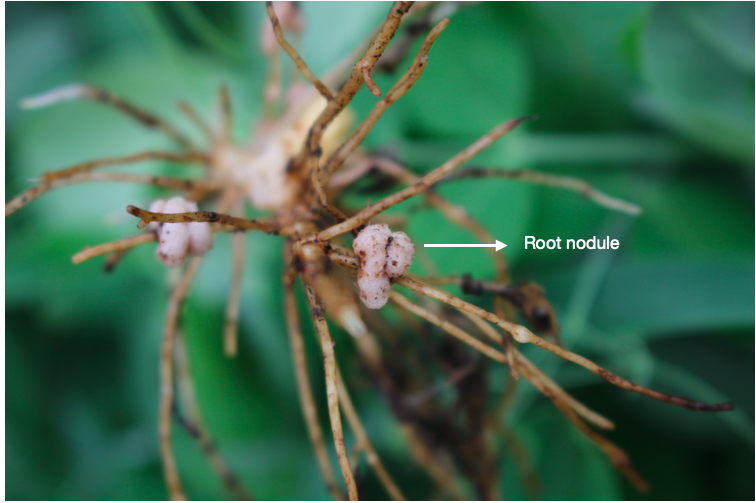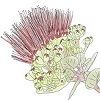2.4: Modified roots
- Page ID
- 59221
Some plant roots may be modified for special purposes in addition to accomplishing the root’s basic functions.
Storage roots
Some plants store carbohydrates in the roots for use in case of emergency or in preparation for the winter months, as some plants lose their leaves and are unable to perform photosynthesis. Most of this storage in plants happens in the roots, where it can be safe from animals and be preserved better than aboveground. We are familiar with this strategy of food storage, as we animals also store extra food as fat in our bodies to use in case of food scarcity. For example, animals that hibernate accumulate fat to be able to survive the winter. Plants do not use fat to store food, instead they use mainly starch, which is more stable and lasts for longer periods of time. Roots have been sources of food for humans since the dawn of our species. Examples of economically important root crops are cassava, sweet potatoes (Figure \(\PageIndex{1}\)), carrots, beets, sugar beets, turnips, radishes, parsnips, and horseradishes.
Currently, the most important root crop in the world is cassava (Manihot esculenta, Figure \(\PageIndex{2}\)). There are dozens of common names for this crop. In Hawaiʻi, it can be known as tapioca. This plant is also originally from South America, but now it is widely cultivated in most tropical and subtropical regions including many Pacific islands. It is the third most important source of carbohydrates in the tropics, behind rice and corn. Cassava can grow in poor soils and in places with low rainfall. Proper cooking and preparation are important, as some varieties contain cyanide that needs to be removed before consumption. Cassava is a versatile crop and can be used in many ways: fried as in french fries, mashed as in mashed potatoes, fermented and made into an alcoholic beverage, and dried into different types of flour with long shelf life (e.g. tapioca flour). The tapioca balls in bubble tea are made of starches extracted from this root.
Another important root is ʻuala or sweet potato (Ipomea batatas). They have been cultivated by Native Hawaiians since prior to European contact and were a very important source of carbohydrates for the population in the islands (Figure \(\PageIndex{1}\)). Sweet potatoes are a very convenient crop as they grow in all kinds of environments: wet, dry, near sea level, and higher elevations. However, it was extensively cultivated in the Kohala agricultural system on Hawai‘i Island (Lincoln and Vitousek, 2017). Many different varieties of sweet potatoes were grown in the past and this crop still is an important component of the diet today, although the majority of varieties grown locally are recent introductions to Hawai‘i.
Sweet potatoes are native to South America, where they were first domesticated. They were cultivated in Hawaiʻi prior to European contact with Hawaiʻi and even the Americas. But how did they travel from South America to Hawaiʻi? There are a few hypotheses that try to explain this. One explanation is that the plant arrived by rafting, or getting a ride on oceanic currents (Montenegro et al., 2008). However, there are linguistic similarities to the names used for sweet potato in Polynesia and the coast of Ecuador. The word for sweet potato in Polynesia is “kumala” which is similar to the original Ecuadorian Quechua word for sweet potato “kumara”. In Hawai‘i the sweet potato is known as ‘uala (Adelaar, 2011). Therefore, it is plausible that Polynesians traveled by canoes as far as South America, traded with the native populations there and brought the sweet potato back home (Roullier et al., 2013).
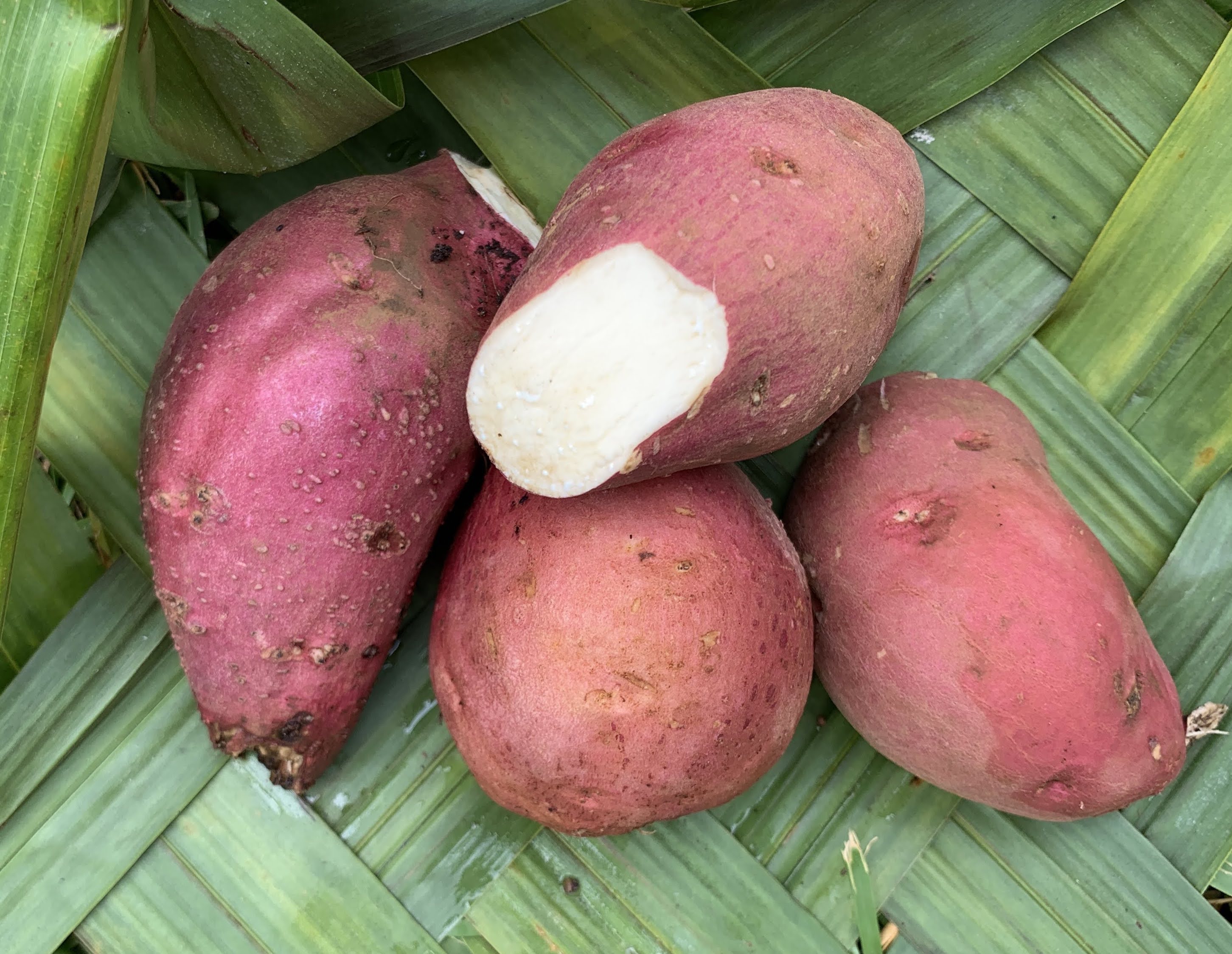
Adventitious roots
Roots usually grow underground, but some modified roots can grow above ground from the stem and they are called adventitious roots. We will subdivide adventitious roots into prop, buttress, and aerial roots.
Prop roots
Prop roots extend from the stem to the soil and provide extra mechanical support to the plant and an increased absorption capacity after they reach the soil. Hala (Pandanus sp.) is a great example of a plant with prop roots (Figure \(\PageIndex{2}\)E). In this plant prop roots can grow 3- 4 meters (10-13 feet) long. Another good example is red mangrove (Rhizophora mangle) which is native to tropical and subtropical places; however, this species is not native to Hawai‘i. The prop roots help to support branches, allowing the tree top to extend laterally, creating a beautiful maze of roots. This also helps the tree to withstand tidal changes and storm surges while creating habitat for fish and other aquatic organisms.
Buttress roots
These modified wall-like roots are characteristic of some large trees growing in the tropics, usually in shallow soils, providing the tree extra mechanical support. Ceibas are great examples of trees with buttress roots (Figure \(\PageIndex{2}\)D).
Aerial roots
Most orchids are epiphytic, meaning they grow on top of other plants, like trees, and not in the soil. This means that their roots are not underground, but grow along the surface of the bark. However, this does not mean they are parasitic, as they are only using the tree as a place to grow and they still gather the water and nutrients from the environment to be able to carry on their photosynthesis. Orchid roots are covered in a thick layer of dead cells called velamen, which looks whitish, that helps to retain water (Figure \(\PageIndex{2}\)B).
Parasitic roots
Some plants have specialized roots, called haustoria, that penetrate other plants to steal water and nutrients. These plants are called parasitic, but the level of parasitism differs among parasitic species. Some parasitic plants steal water and are still capable of undergoing photosynthesis to produce their own food, like the mistletoe plant. Other parasitic plants are absolute parasites that do not even have chlorophyll to be able to carry on the process of photosynthesis, meaning they must obtain water and food from the host plant in order to survive. An example of a fully parasitic plant is dodder. The Kauna'oa kahakai (Cuscuta sandwichiana) is an example of a Hawaiian endemic plant that is fully parasitic (Figure \(\PageIndex{2}\)C).
Reproductive Roots
Roots from certain species can produce new plants via asexual reproduction. This is very common in stems and relatively rare in roots. This type of modification allows the plant to grow a new individual from their root systems. This is the case of breadfruit. If the main breadfruit tree gets damaged by animals like pigs, the tree will send out new shoots from its root system. If the main tree dies, this new plant can grow and become a new tree. Even if the tree is only damaged, the new plant can grow and become its own individual. People all over the Pacific take advantage of this reproductive strategy to propagate breadfruit. Since many varieties do not produce seeds due to human domestication, the roots are used to propagate existing trees (Figure \(\PageIndex{2}\)F).
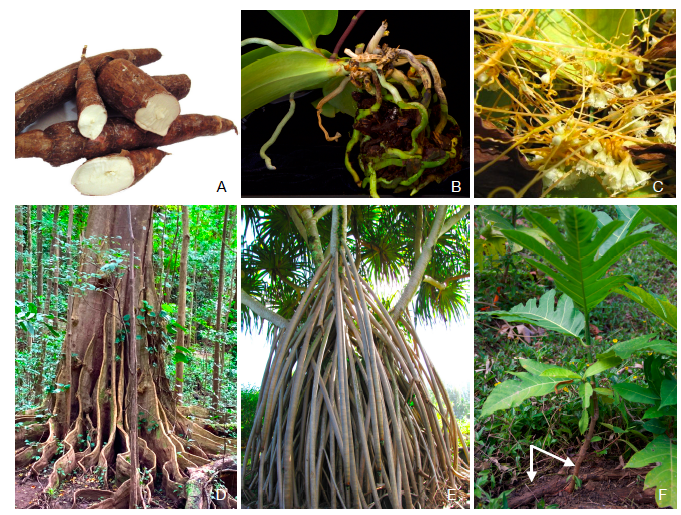
Mycorrhizae
Mycorrhiza (myco = fungus; rhiza = root) is a symbiotic relationship that most plants have with fungi in their roots (Figure \(\PageIndex{3}\); mycorrhizae is the plural form of mycorrhiza). Symbiosis means “relationship” which can be mutualistic, commensalistic, or parasitic. Sometimes both partners get something from this relationship (mutualism), other times, the fungus or the plant may not get anything in return (commensalism; Pringle et al., 2011). The fungal body is called mycelium (plural mycelia) and it is composed of root-like extensions called hyphae that absorb water and scavenge the soil for nutrients like phosphorus or nitrogen and give it to the host plant, increasing the total absorptive capacity of the plant. In exchange, the plant may give the fungus carbon (normally in the form of glucose) produced in photosynthesis.
There are two types of mycorrhizae: ectomycorrhizae (Figure \(\PageIndex{3}\)A) where the fungi grows its hyphae (root-like fungi body) in the outermost layers of the cortex cells of the root. This type of mycorrhiza is commonly found in trees. Endomycorrhiza (Figure \(\PageIndex{3}\)B) is when the hyphae penetrates the cortex cells, all the way to the endodermis. Sometimes the hyphae will swell up and form vesicles which store nutrients derived from the plant-fungus interaction (Figure \(\PageIndex{3}\)B). The fungi does not damage the plant cells. Endomycorrhiza is found in woody as well as herbaceous plants.
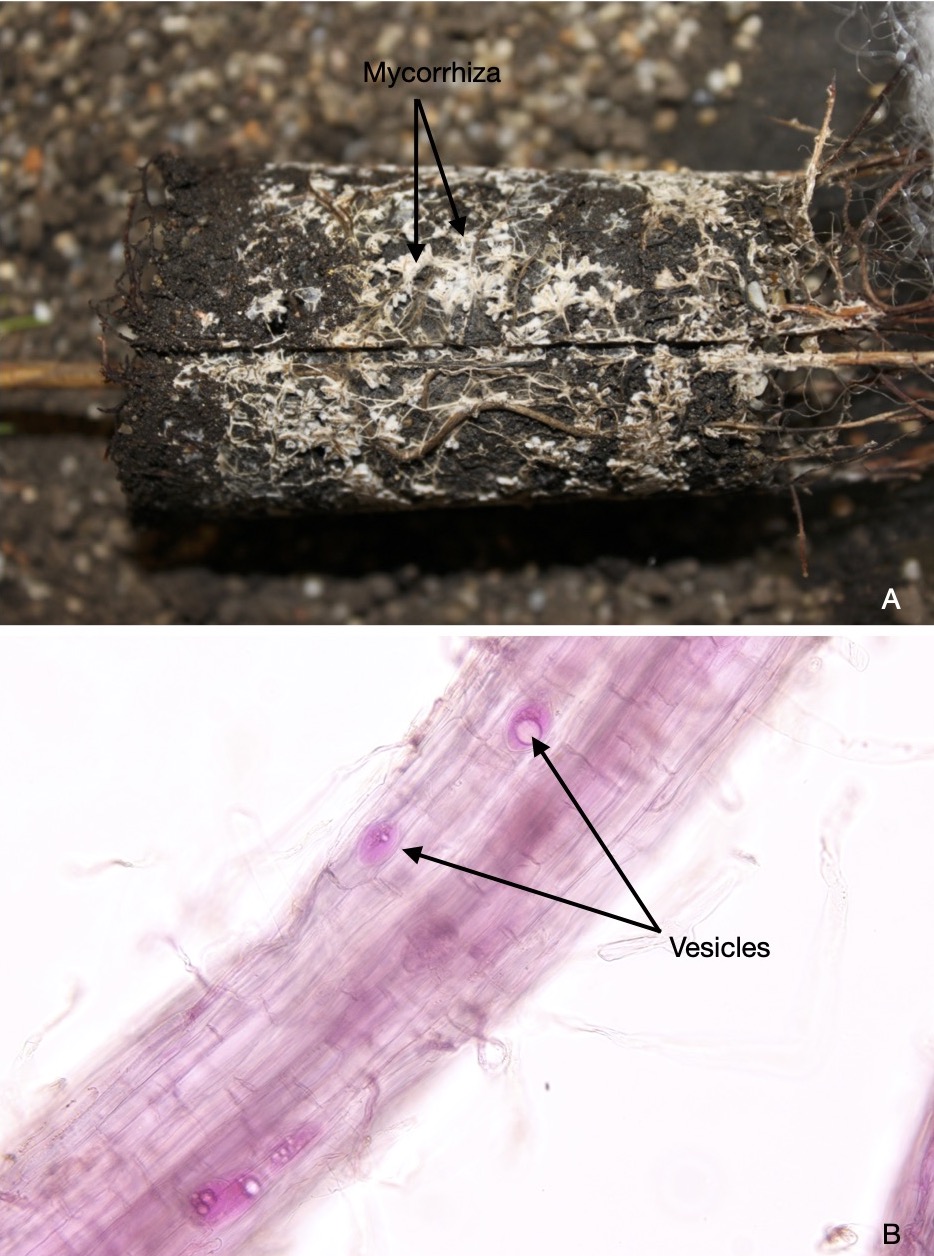
Root nodules
Nitrogen is one of the macronutrients plants need in order to grow. Although it comprises 79% of the air, plants cannot absorb it directly from the atmosphere. In fact, most organisms, including animals, cannot absorb nitrogen in its gaseous form. Fortunately, some nitrogen-fixing bacteria are capable of fixing or changing nitrogen into a usable form (i.e. nitrates). Some plants have the capability of forming a symbiotic relationship with some species of these bacteria in their roots, increasing nitrogen absorption. The plant forms a rounded structure in their roots called nodules that host and protects the nitrogen-fixing bacteria (Figure \(\PageIndex{4}\)). Plants with this mutualistic association include plants in the legume family (Fabaceae) like beans, peas, and peanuts. Other families of plants are also able to have this kind of relationship with bacteria.
